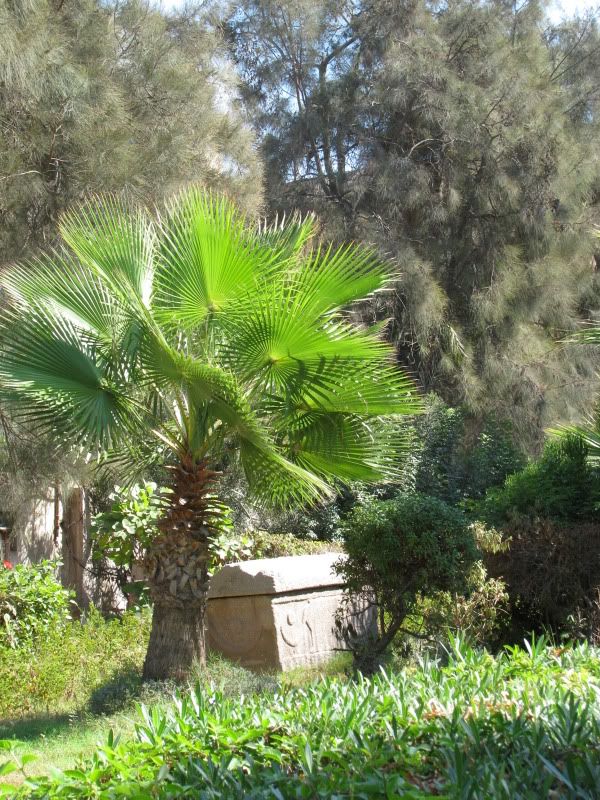The first place we visited upon arriving in Alexandria was a place I for my part had never heard about before I got to Egypt. Shame on me, I guess. The catacombs of Kom el Shoqafa - an underground necropolis that was in use from the 2nd through the 4th century AD, and then, upon becoming disused, was lost to human knowledge before being rediscovered in supposedly a rather surprising way in 1900.
Because of the specific period in which this burial site was being used, it is unusual in its iconography; a confluence point for many cultural influences. There is evidence of the Pharaonic funeral cult, but there are also very strong Hellenistic influences, as well as early Imperial Roman stylistic features. It's quite amazing - you'll see Egyptian statues, for instance, that wear Roman clothes. :-) The styles are blended in many ways. A very special sight.
The history of the catacombs is somewhat unclear. It's believed that it was originally constructed as a burial site for only one family - a very rich and powerful one, of course. :-) Eventually it was expanded to also make room for other families. There are a lot of chambers in this underground labyrinth, and graves of various sizes. Some are very elaborate and others much simpler. There are also rooms where living family members could assemble to celebrate their lost loved ones, and of course the place was set up for divine worship.
As I said, the catacombs were forgotten for many centuries. They were rediscovered supposedly by accident many many years after they had fallen out of use. The name of the place, Kom el Shoqafa, means 'potshards', and the circumstances of rediscovery were in a way what gave it this name. Basically the area became a landfill ... when the site was an active necropolis, those visiting the graves would bring gifts to the deceased, often food, in terracotta and other clay containers, which they then would not want to be bothered carrying back home, since they'd be empty. So a kind of dump developed on the site. Later, no one remembered what was underground, and it was to them just a mound of potshards. :-) The 'official' story of the discovery goes like this: One day in late September 1900 a man was passing across this dump with his donkey, and was quite startled when the animal suddenly fell into a hole in the ground. In the process of extracting his four-legged friend he realized that this wasn't just any dinky little hole ... this was some serious shit right here. :-) He alerted others to his discovery, and the rest is history. In reality, excavations had been ongoing on the site for some years, but they hadn't found anything until the fall of 1900. As you can imagine, archaeologists worldwide were very excited when news broke that the excavations had finally begun to yield results.
On many lists of great wonders of the medieval world, Kom el Shoqafa is named as one of the seven. It has only been open to the public since 1995, since there's been a lot of problems with water in the lower levels.
Unfortunately, I don't have any pictures from inside the catacombs, as we weren't allowed to take any there. I've just got a few from the outside - they have some statues and sarcophagi and things on display there. But keep reading ...
The entrance gate. It looks deceptively humble.
 A closer view ...
A closer view ... Officers from the tourist police guard the entrance, of course. But they were relaxing in the shade when we arrived. :-)
Officers from the tourist police guard the entrance, of course. But they were relaxing in the shade when we arrived. :-) Some of the sarcophagi ... which have been used as coffins at some points and as bathtubs at others. :-D *
Some of the sarcophagi ... which have been used as coffins at some points and as bathtubs at others. :-D * Another coffin. *
Another coffin. * Statues and pillars are among the other artifacts on display outside, or rather above, the necropolis. *
Statues and pillars are among the other artifacts on display outside, or rather above, the necropolis. * A bit of the lovely little park that surrounds the display area of the site.
A bit of the lovely little park that surrounds the display area of the site. CH taking some pictures.
CH taking some pictures. If you want to see some pictures of the interior, and also read some more about Kom el Shoqafa, you can go here.
If you want to see some pictures of the interior, and also read some more about Kom el Shoqafa, you can go here.
The photos in this post marked with an asterisk are by CH, the others are by me. :-)







1 comment:
still cool one year on
Post a Comment